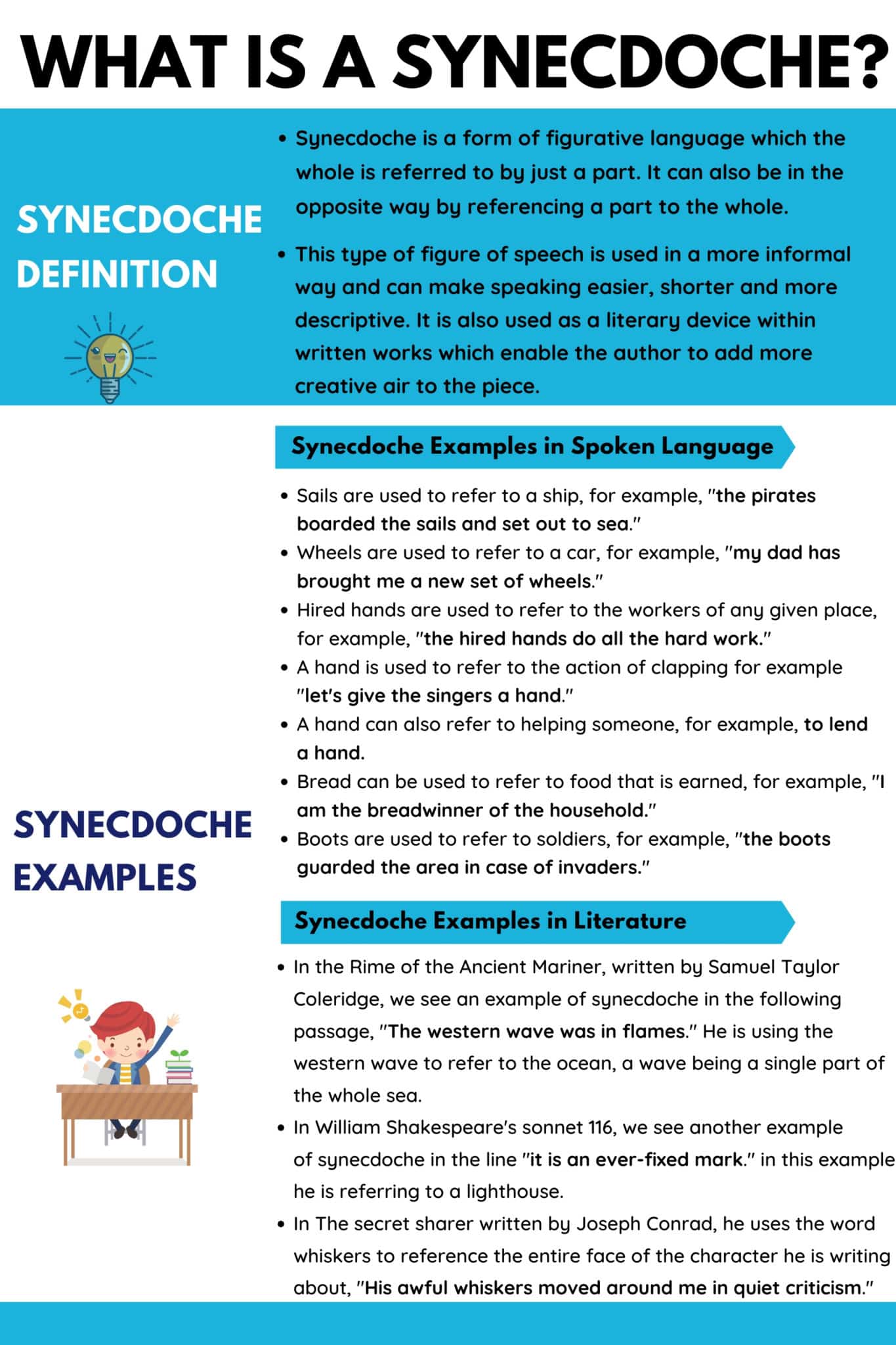You may have come across the term synecdoche when studying the English language, but what does this mean? It is a term you are likely to frequently come across and can be easily understood. In this article, we are going to be taking a look at the definition of synecdoche as well as looking at some examples of synecdoche in use in both spoken language and in a written context. By doing this we will further be able to understand how it is used.
Table of Contents
Synecdoche
Synecdoche Meaning
What is synecdoche?
Synecdoche is a form of figurative language which the whole is referred to by just a part. It can also be in the opposite way by referencing a part to the whole.
This type of figure of speech is used in a more informal way and can make speaking easier, shorter and more descriptive. It is also used as a literary device within written works which enable the author to add more creative air to the piece.
Synecdoche Examples
Synecdoche in Conversation
You are very likely to hear some form of synecdoche often during an English conversation, it is a very commonly used type of figurative language. We are now going to take a look at some examples of how synecdoche can be used in day to day spoken language.
- Sails are used to refer to a ship, for example, “the pirates boarded the sails and set out to sea.“
- Wheels are used to refer to a car, for example, “my dad has brought me a new set of wheels.“
- Hired hands are used to refer to the workers of any given place, for example, “the hired hands do all the hard work.“
- A hand is used to refer to the action of clapping for example “let’s give the singers a hand.“
- A hand can also refer to helping someone, for example, to lend a hand.
- Bread can be used to refer to food that is earned, for example, “I am the breadwinner of the household.”
- Boots are used to refer to soldiers, for example, “the boots guarded the area in case of invaders.”
- Bubbly is used to refer to the drink, Champagne which contains bubbles, for example, “let’s crack open some bubble and celebrate my new job.“
- “The world is against me.” This example uses the word world to refer to everyone.
- “The Huffington Post wrote a very interesting story.” Here, synecdoche is used by referring to one journalist as the Huffington Post.
- The word suit is used to refer to businessmen. For example “John has a pretty boring job as one of the suits.“
- Glasses can be used to refer to any sort of eyewear, for example, “I have to wear glasses to be able to read.“
- The heart is used to refer to love or romance, for example, “I love you so much that I give you my heart.“
- The word glass can be used to refer to a drink, for example, “Can you buy me another glass.“
- The sword can be used to refer to killing, even though killing can be achieved by more than just a sword, for example, “the soldiers all faced the sword.“
Synecdoche in Literature
As we previously mentioned, synecdoche can be used as a literary device in order to refer to a whole by using a part. Let’s now take a look at some examples of times in which writers have used synecdoche within their written works.
- In the Rime of the Ancient Mariner, written by Samuel Taylor Coleridge, we see an example of synecdoche in the following passage, “The western wave was in flames.” He is using the western wave to refer to the ocean, a wave being a single part of the whole sea.
- In William Shakespeare’s sonnet 116, we see another example of synecdoche in the line “it is an ever-fixed mark.” in this example, he is referring to a lighthouse.
- In the piece written by Percy Shelley, Ozymandias, we see an example of synecdoche being used in the following passage, “They survive, stamped upon these lifeless things, by the hand which made them.” He is using the word hand to refer to a sculptor.
- In The secret sharer written by Joseph Conrad, he uses the word whiskers to reference the entire face of the character he is writing about, “His awful whiskers moved around me in quiet criticism.”
- In The description of morning written by Jonathan Swift, there is an example of synecdoche when he uses the term broom stumps to refer to the whole broom. This can be seen in this extract “Be prepared to scrub the stairs and entryway, youth with their broomy stumps start to trace.“
- Frank R Stockton writes The lady or the tiger, in which we see an example of synecdoche in the line “their eyes met as she sat in front of him paler than anyone in the huge ocean of faces before them.” The writer uses the term faces to refer to people.
- In the novel Beloved written by Toni Morrison, we see an example of synecdoche in the line “There, they do not love the flesh of you. They hate it.” In this example, the writer is using the term flesh to refer to the whole person.
- In the play Macbeth, written by William Shakespeare, an example of synecdoche can be seen in the excerpt “take your face hence.” in which Shakespeare is referring to the whole person by using the word face.
Conclusion
By looking at examples of synecdoche, we have been able to further understand it functions within both a conversational context and within written work.
In short, synecdoche is a type of figurative language which uses a part to refer to the whole of something. It is used commonly within the English language. It can be used in many idioms and slang terms in order to make speaking more simple and short. Synecdoche can also be used to reference a whole to a part as well as the other way around.




